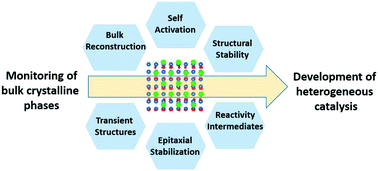How the in situ monitoring of bulk crystalline phases during catalyst activation results in a better understanding of heterogeneous catalysis
Abstract
The present Highlight article shows the importance of the in situ monitoring of bulk crystalline compounds for a more thorough understanding of heterogeneous catalysts at the intersection of catalysis, materials science, crystallography and inorganic chemistry. Although catalytic action is widely regarded as a purely surface-bound phenomenon, there is increasing evidence that bulk processes can detrimentally or beneficially influence the catalytic properties of various material classes. Such bulk processes include polymorphic transformations, formation of oxygen-deficient structures, transient phases and the formation of a metal–oxide composite. The monitoring of these processes and the subsequent establishment of structure–property relationships are most effective if carried out in situ under real operation conditions. By focusing on synchrotron-based in situ X-ray diffraction as the perfect tool to follow the evolution of crystalline species, we exemplify the strength of the concept with five examples from various areas of catalytic research. As catalyst activation studies are increasingly becoming a hot topic in heterogeneous catalysis, the (self-)activation of oxide- and intermetallic compound-based materials during methanol steam and methane dry reforming is highlighted. The perovskite LaNiO3 is selected as an example to show the complex structural dynamics before and during methane dry reforming, which is only revealed upon monitoring all intermediate crystalline species in the transformation from LaNiO3 into Ni/La2O3/La2O2CO3. ZrO2-based materials form the second group, indicating the in situ decomposition of the intermetallic compound Cu51Zr14 into an epitaxially stabilized Cu/tetragonal ZrO2 composite during methanol steam reforming, the stability of a ZrO0.31C0.69 oxycarbide and the gas-phase dependence of the tetragonal-to-monoclinic ZrO2 polymorphic transformation. The latter is the key parameter to the catalytic understanding of ZrO2 and is only appreciated in full detail once it is possible to follow the individual steps of the transformation between the crystalline polymorphic structures. A selected example is devoted to how the monitoring of crystalline reactive carbon during methane dry reforming operation aids in the mechanistic understanding of a Ni/MnO catalyst. The most important aspect is the strict use of in situ monitoring of the structural changes occurring during (self-)activation to establish meaningful structure–property relationships allowing conclusions beyond isolated surface chemical aspects.

- This article is part of the themed collections: 2021 Highlight article collection and Nanomaterials


 Please wait while we load your content...
Please wait while we load your content...